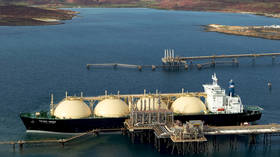Australia becomes top LNG exporter despite bushfire crisis

Australia’s bushfire crisis has arrived to such a tragic and critical apex that the smoke from the climate change-fuelled fires has travelled nearly 10,000 miles to South America and may have reached the Antarctic.
That's according to a terrifying report released by the United Nations’ World Meteorological Organization on Tuesday, as reported by Reuters.
“But skies as far away as over central Chile have now gone grey because of the smoke and the WMO cited reports that the sunset in Argentina’s capital, Buenos Aires, had turned red,” said Reuters. “The fires, which have raged for months in Australia, have already emitted 400 megatonnes of carbon dioxide into the atmosphere and produced harmful pollutants,” the article went on to paraphrase the EU’s Copernicus monitoring programme.
Also on rt.com Australian fires that killed half a BILLION animals expected to reach ‘blast furnace’ conditions, force record evacuations (VIDEO)The possible arrival of smoke from the bush fires to Antarctica is of particular concern, as soot deposits darken the ice and speed their melting, thereby contributing to even greater rates of global warming in a vicious cycle that will lead to more of these kinds of catastrophic fires. “Brown sooty deposits have already been reported on glaciers in New Zealand, potentially accelerating the rate at which they are melting,” the Copernicus programme told Reuters.
In another ironically appropriate twist, at the same time that Australia is experiencing the dramatic tragedy of the bushfires has also overshadowed the country’s recent distinguishment of becoming the world’s single-biggest exporter of liquefied natural gas (LNG). “A series of new projects around the Australian coast have contributed to global LNG leadership with analysis by the industry consultancy, Energy Quest, calculating that Australia shipped 77.5 million tons of the super-chilled gas in 2019,” reported Forbes. For reference, the United States, the world’s fastest growing producer of natural gas, exported less than half that amount, clocking in at just 34.3 million tons of exported LNG in 2019. Also, notably, the tiny gulf country of Qatar came in second for LNG exports at a whopping 75 million tons as estimated by Energy Quest (the official data has not yet been released).
As summed up by Forbes in an article titled “Raging Bush Fires Dampen Australia’s LNG Export Achievement,” there is a division in Australia between the fast-growing LNG industry and dissidents who point to fossil fuel emissions and global warming as the impetus of the bushfires. “Not everyone in Australia will be impressed with the country’s status as a fossil fuel leader with pressure growing to put a cap on coal production and growing uncertainty about whether being biggest in LNG is a laudable achievement if natural gas is playing a role in global warming and climate change which is said to be fanning the bush fires which have so far killed 24 people and destroyed an estimated 1500 homes,” the article reports.
Also on rt.com Australia’s Northern Territory scraps fracking banWhat’s more, the country’s LNG industry is not going to be curbed by the bushfires, but is actually set to continue growing in the next year. “Australia’s exports came from projects in Queensland on the east coast, Western Australia and the Northern Territory,” writes Forbes, “with more to come as new developments such as the Scarborough and Browse LNG developments move towards formal development commitments.”
Much of global demand for LNG is coming from Asia, which has a nearly insatiable hunger for the import, and, in fact, the biggest driver of the increase in Australian LNG exports in the last year was a Japanese-owned project called Ichthys. Mostly thanks to Ichthys, Australian LNG exports increased 11.4 percent in the last year as compared to 2018.
Australia is set to become a fascinating litmus test for the power of public awareness of global warming and the ramifications of greenhouse gas emissions versus the energy industry. If something as dramatically catastrophic as the bushfires do not dampen the growth of the LNG industry on the same soil, it does not bode well for the increasingly important fight against catastrophic climate change.
This article was originally published on Oilprice.com













